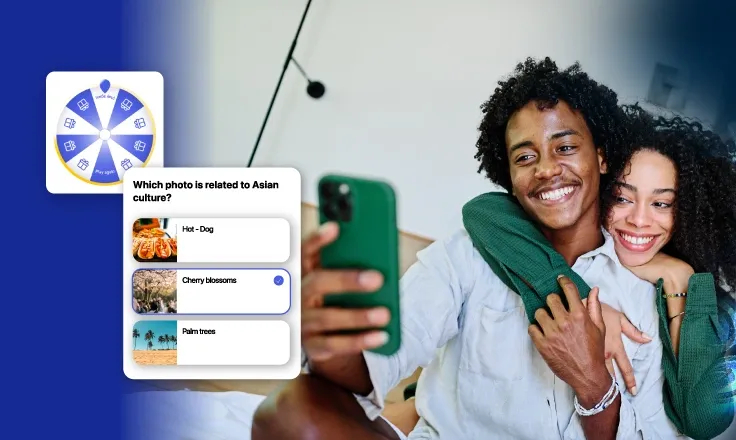Level Up Your Loyalty Game: Everything You Wanted to Know About Gamification
- Published
- 24 min reading

Our recent webinar, Level Up Your Loyalty Game: Why Gamification is the Missing Engine in Modern Customer Engagement, sparked plenty of great questions – more than we could fit into one hour. It would be a shame to just leave them hanging, so we’ve gathered some of the most interesting ones here, along with our experts’ thoughts. From finding the right balance between monetary and emotional rewards to tailoring gamification mechanics to different generations, here’s what we didn’t have a chance to cover during the session.
We’ve introduced a few games to our loyalty program, but the monetary reward remains the primary driver of engagement. What can we do to make the experience itself more attractive, so it becomes a bigger driver than the reward?
That’s a very common challenge. The key is to balance extrinsic motivations (like the monetary prize) with intrinsic ones (the satisfaction of the activity itself). While extrinsic rewards are great for capturing someone's attention, intrinsic motivation is what fosters a genuine, long-term emotional connection.
To make the experience rewarding, focus on creating a sense of achievement, social connection, and purpose. Try adding small challenges that use knowledge or skills, like product quizzes or micro-missions, and introduce light team-based competitions. When a customer wins, they receive the prize, along with a sense of mastery and accomplishment.
How can you tell if gamification is actually building emotional connection, rather than just generating clicks or log-ins?
Look for engagement in activities that have no direct monetary value. Are your members completing quizzes, customizing an avatar, or earning badges, even if there is no direct reward? Are they participating in community features, like team challenges or leaderboards? That's a sign of intrinsic motivation. When customers invest time in achievements that hold only symbolic value, they’re building a sense of connection and ownership – a foundation for long-term loyalty.
What are your thoughts on the cost and effort of implementing gamification natively within loyalty apps vs connecting popular existing mobile games to earn additional rewards?
Native always wins for long-term loyalty because it keeps the experience, data, and brand narrative under your control. External game partnerships are great for short-term bursts or acquisition campaigns, but they rarely build lasting loyalty. Of course, they’re much faster to launch, but you’re essentially just “renting” these users' attention, and the loyalty they have is to the game, not necessarily your brand.
How can we integrate gamification into an e-commerce app? Should it have eligibility criteria, such as a certain number of points or a specific count of a particular activity, to unlock it for users, or should it be available on the go?
It’s best to make gamification visible and accessible to everyone from day one. If you hide gamification entirely until they earn points, most users will never reach it. Additionally, if a new user opens your app and sees a fun feature they are locked out of, you can create frustration, and that’s certainly not the goal. Gamification can also be a great onboarding tool. A welcome quest or a badge for completing their profile is a fantastic way to engage new users immediately.
How can we best leverage the gamification functionality with the AI module?
AI makes gamification adaptive rather than static. It can automatically adjust the difficulty, reward size, and timing based on each user’s behavior pattern. It also predicts churn risk and triggers a “save mission” before disengagement happens. It can create personalized quizzes and challenges – a user who prefers eco-actions gets sustainability quests, while another gets cashback or access-based incentives.
Has using leaderboards and competitions ever been successful in the financial services industry?
Yes, absolutely. It might seem counterintuitive for a “serious” industry, but gamification can be effective in almost every sector – it just needs to be done thoughtfully. Some banks use monthly challenges or progress-based goals to encourage everyday actions, such as card payments or savings. Others gamify education around financial literacy or app usage, driving both engagement and customer satisfaction.
For example, the National Bank of Bahrain’s program, “Points by NBB,” uses “Points Monthly Challenges” to transform everyday banking activities, such as ATM withdrawals or daily spending, into a fun and rewarding game. On the other hand, by gamifying its customer education process, Extraco Bank achieved a 700% increase in customer acquisitions.
How can gamification function in the hospitality industry, especially in restaurants or bars?
Hospitality is a perfect fit for gamification because it’s built around repeat visits and experiences. You can use streaks (“Visit five times this month for a free drink”) or discovery challenges (“Try all three seasonal dishes”). Additionally, small interactive moments like spin-to-win or scratch cards after checkout add surprise and fun, encouraging people to return.
How can a tech company that specializes in loyalty promotions for banks use gamification in its own loyalty campaigns?
By applying the same principles it offers to banks: using gamified challenges, tiered rewards, and real-time progress tracking to drive engagement. The company can turn its own client activities — such as launching campaigns, completing training, or sharing feedback — into missions that unlock benefits or badges. This approach showcases its expertise, strengthens client relationships, and demonstrates the real-world impact of its solutions, reinforcing the growing need for loyalty technology providers to model best practices themselves.
Are you seeing any generational differences in customer response to gamification engagement? If so, what is the best practice to address that?
Yes, and it’s usually connected to different expectations. While older generations (like Boomers or Gen X) respond well to long-term value and status, making tiers and progress bars highly effective, Gen Z is more motivated by immediacy, social connection, and purpose. This means they respond better to instant rewards, such as “spin-to-win” games, social leaderboards, and purpose-driven quests. The best practice is to use a segmented, AI-driven approach. An intelligent loyalty platform can identify these different preferences and automatically serve the right game mechanics to the right person.
How would you handle customers who “lose” their streak, since this can lead to a decline in interest?
First of all, never let them feel punished. Offer a recovery option, like a free pass once a month, or a short comeback mission that lets them regain progress. Streaks can be a powerful motivation, but they can just as easily turn into a source of frustration. When a user loses their streak, send them a notification: "Oh no! Complete this one-time challenge in the next 24 hours to win your streak back!". The goal is to make your members feel invited back, not disqualified.
How would you recommend measuring ROI or success KPIs of gamification?
Start with engagement metrics, including frequency of interactions and retention rates. These will let you see if people are actually engaging with your gamification mechanics. Then link these to business outcomes, like customer lifetime value (CLV) or purchase frequency. Compare customers who engage with gamified elements to those who don’t. Gamification should ultimately support commercial goals, but it can also enhance softer metrics, such as satisfaction and advocacy, both of which are important indicators of emotional loyalty.
Can gamification be overused?
Absolutely. You can “over-gamify” your program by adding too many game elements or using the mechanics that don’t feel authentic to your brand. If a user opens your app and is immediately bombarded with points, badges, pop-ups, and leaderboards all at once, they will likely feel confused and overwhelmed. This actually lowers their desire to engage and leads to frustration. It can also happen when the mechanic feels like a chore, when it becomes too frequent, or when rewards lose their meaning. The best practice is to keep it simple. Start with just one or two mechanics that are perfectly aligned with a single, clear business goal.
Let’s Continue the Conversation on Gamification
Gamification has evolved from being a buzzword to a powerful tool that significantly shapes how people interact with brands. It helps turn routine actions into moments of engagement and keeps customers genuinely interested.
Thank you again to everyone who joined the webinar and shared their thoughts. If you missed it, you can still watch the full recording and see how companies are already using gamification to make loyalty more engaging and effective.


